Maintaining an aesthetic physique comes with various challenges, including walking the tightrope cutting fat, and putting on muscles. Bodybuilders often go through multiple approaches to chisel their figure in a way they would deem fit. But Dr. Peter Attia recently unveiled some of the best methods to achieve this.
Eating less to lose fat could work either through direct or indirect approaches, depending on the circumstances of an individual. Ideally, bodybuilders would resort to reducing calories when they aim to cut, but Dr. Attia introduced three methods for the purpose.
- Caloric Restriction
- Dietary Restriction
- Time Restriction
While all three methods work on refraining from an element, they behave in very different ways. Caloric restriction is the direct approach that bodybuilders resort to, where they keep a count of every calorie consumed and eliminate them accordingly. Whereas the other two methods are indirect approaches that ultimately result in fat burning.
Dietary restriction involves following a particular diet plan that cuts down on certain food families. This way, the individual ends up indirectly burning fat by eliminating a sizable number of foods from their consumption. On the other hand, time restriction translates to practising some form of intermittent fasting, where one stops food intake for many hours. But this method only works if the individual is not over-nourished and under-muscled.
“I get worried about excessive time restriction because with calorie restriction comes protein restriction, and with protein restriction comes not just a reduction in mass…but a disproportionate loss of lean mass.”
Talking to physiology professor Dr. Luc Van Loon, Dr. Attia discussed how time restriction and caloric restriction could work in similar ways. However, since the goal was to ultimately increase lean muscle mass, he suggested distributing one’s daily protein intake smartly while time-restricting your meal. During intermittent fasting, individuals spend a significant amount of time without eating.
“A workaround is…during that period of time you’re going to have two shakes that are virtually no calories but are going to give you 50 grams of protein…so you’re going to get your total amount of protein…”
But this wasn’t the only solution that the duo presented to those wanting to burn fat without the risk of sacrificing their muscle. Dr. Loon suggested changes in workout routines that could help enhance dietary practices.
Dr. Peter Attia and Dr. Luc Van Loon reveal how resistance training could help
While Dr. Attia had already suggested regulating one’s protein intake to keep the muscle mass intact, merely practicing that wouldn’t make much difference. One needed to include particular workout practices to make sure the proteins were being optimally synthesized.
Dr. Loon revealed that practicing resistance training at least twice a week helps the body respond to the protein intake. Following such training sessions, any meal consumed would respond in a more pronounced and significant way. Hospitals often followed this hack by not only feeding patients protein-rich diets but also getting them to move in between to increase their strength. Workouts and diet plans go hand-in-hand when one needs to grow muscle size.





